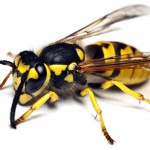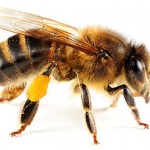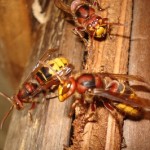Bees and Bee Hives

Bees are an important part of the ecology, but they do become a concern when they decide to take refuge in or around your home. There are a variety of bees that exist and each has their own types of beehives they create. Having the bee hives and their residents too close to home can cause problems and a danger to your family and pets due to the pain of their sting and possible allergies they cause. Below is a listing of some of the most common bees and their beehives.
Yellow Jackets

They are recognized by yellow and black stripes. They are most often found in trees and shrubs but become more of a problem when they take refuge in the eaves of your home and under the decks. Their bee hives are easily recognizable as an oval-shaped construction of gray paper. They make their own “paper” by chewing on tiny slivers of wood. They lay their eggs in those hives and the young are hatched there. The yellow jacket sometimes gets inside the walls or ceiling of your home, evident by sounds of a crackling and rustling noise as they are building more hives while chewing through your plaster and walls.
Wasps

Wasps are very predominant in shape, long and thin at the waist. They favor building eaves and gutters as a way to get into attics. They will also build their nest or hive behind shutters, in grills, under deck railings, in or under mailboxes, swing sets and light fixtures. The bee hive of a wasp is rather small so that it can be tucked into or under any area.
Carpenter Bees

As the name denotes, carpenter bees love wood and can literally “drill” into the wood of your home. They make tunnels in the wood, creating their own type of hive within those tunnels in order to lay eggs and raise their young. Left untreated, this bee hive can grow to extreme numbers around your home. Carpenter bees are not destructive of your home since they do not go beyond the surface of the wood without harming rafters, studs and joists.
Honey Bees

This bee is one of the most vital for the environment as they are needed for pollination. As we know how beneficial they are, when the honey bee invades your home, it becomes a problem. Honey bees produce massive hives with thousands of bees. As they welcome themselves into your structure, you may not visibly see their hive although you will note them constantly flying in and out of your cracks and crevices of the home’s exterior. Ridding a honey bee problem most often takes great skill as every effort is made to remove the hive and relocate it to a safer, more suitable area away from the home. If all else fails, the hive may need to be destroyed to resolve the bee problem.
Hornets

The hornet is one of the scariest of pests to have around your home. They have the most painful sting and can do so through layers of clothing. Hornet’s hives and nests are up in the eaves and under the decks. Their hives are similar in color and construction to that of the yellow jacket; a tear-drop shape that is constructed of the gray paper they make themselves. They lay their eggs in those nests which consist of cells that are six-sided hexagons. The young and stored food is in those cells.
Recognize the types of beehives invading your home and living space, and the pests that reside there so that you can get professional pest control. Eliminating bees are your own is not effective and can cause more harm than good if you get them angry. Professional pest control specialists are specifically trained, equipped and protected in order to handle your bee problem and their bee hives in the best interest of your family, home and the environment.

Comments are closed.